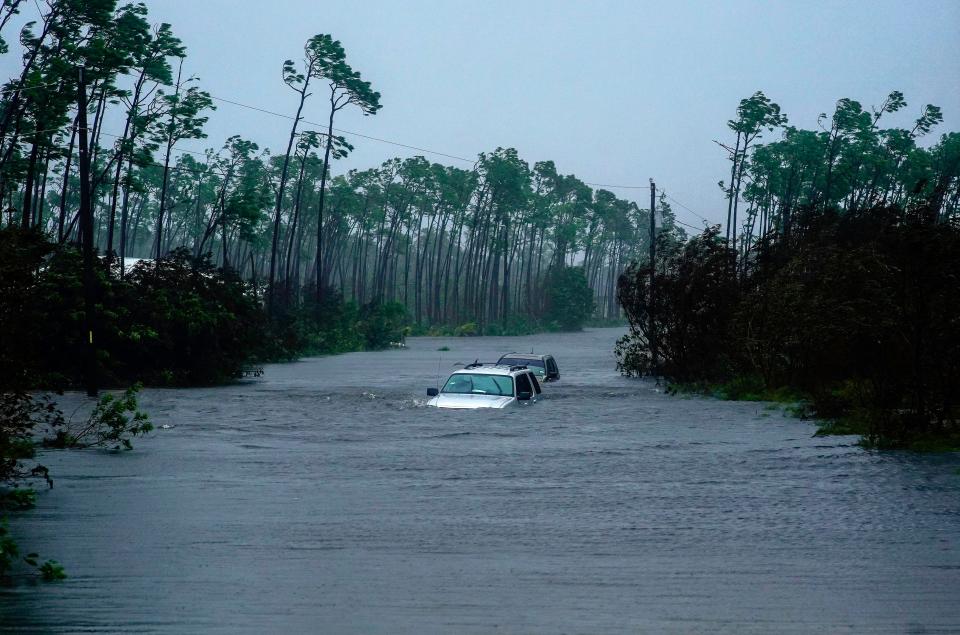'Life-threatening' Hurricane Dorian begins lashing central Florida coast, heading northwest
Even though Dorian has been "downgraded" to a Category 2 storm, it remains a powerful, potentially more dangerous hurricane Tuesday as it continues to lash the Florida east coast.
"The headline for this Dorian advisory is NOT that the wind speed has slightly decreased," the National Hurricane Center said in its late-morning report, when the winds were reduced to 110 mph. "The combined wind, surge and flood hazards are the same or even worse since the hurricane has become larger."
How much larger? As of 5 a.m. EDT on Wednesday, hurricane-force winds extend outward up to 60 miles from the storm's center, up from 45 miles earlier on Tuesday. (Hurricane-force winds are 74 mph or stronger.)
That means hurricane-force winds battered parts of the Florida coast Tuesday evening, and will spread northward up the coast on Wednesday, according to WeatherBug.
"Tropical storm-force winds in excess of 39 mph will reach far inland into central and northern Florida as the hurricane moves northward parallel to the coast," the firm said in an online report.
"Although Dorian's top winds are weakening, the circulation is getting spread over a larger area, so there will still be plenty of wind energy pushing water toward the Southeast coast," said Weather Underground meteorologist Robert Henson, in an e-mail to USA TODAY.
The Pentagon has mobilized thousands of troops, evacuated dozens of warplanes and positioned rescue helicopters and trucks along the East Coast to prepare for Dorian's arrival.
The military also has made 26 bases in the southeast available to the Federal Emergency Management Agency for relief operations.
The Air Force flew more than 100 warplanes to safe locations from seven bases from the expected path of Dorian. That included more than 80 F-16, F-15 and A-10 jets from bases in Florida and Georgia. The Air Force was hit particularly hard last year by Hurricane Michael, a Category 5 storm that devastated Tydnall Air Force Base in Florida's panhandle. That storm caused an estimated $4.7 billion to the base, home to the Air Force's most sophisticated fighter jet, the F-22.
Air Force personnel were also evacuated from five bases, said Ann Stefanek, an Air Force spokeswoman.
In the Navy, Vice Adm. Andrew Lewis ordered ships in the Hampton Roads, Va. region to be ready within 24 hours to escape the storm's path or ride out Dorian in the harbor, the world's largest naval installation.
Air Force Gen. Terrence O’Shaughnessy, who leads Northern Command, told reporters at the Pentagon Tuesday that more than 5,000 National Guard troops and 2,700 active-duty troops are preparing to respond to Dorian.
Because the storm is growing in size, Colorado State University meteorologist Phil Klotzbach warned, it is "still quite dangerous" for the southeast U.S.
"Assuming the track doesn't deviate to the left too much, Florida should be spared the worst potential impacts, but it could still have very significant impacts for Georgia and especially the Carolinas later this week," Klotzbach said in an e-mail.

The National Weather Service said that "not only is Dorian expected to bring life-threatening storm surge and dangerous winds to some areas, additionally, the flash flood threat will increase today and tonight along the Florida peninsula, then spread up the Southeast and mid-Atlantic coast during the middle part of the week."
"The risk of life-threatening storm surge and hurricane-force winds continues to increase along the coast of North Carolina," the Hurricane Center said.
One of the biggest potential impacts is storm surge — the rush of seawater that comes ashore as a hurricane nears land — which is often the deadliest and most destructive part of a storm. In fact, only 8% of hurricane-related deaths are caused by strong winds, while almost half are because of storm surge, the Weather Channel said.
"Remember that storm surge is not correlated with the Saffir-Simpson scale," Henson said. The Saffir-Simpson scale is strictly a wind scale, with its familiar Categories from 1 to 5.
Dorian's weakening, in terms of wind speed, is to be expected: "It's not surprising that Dorian has weakened," Henson said. "If anything, it's impressive that Dorian has remained as strong as it is despite holding nearly stationary for more than a day.
"A slow-moving hurricane churns up cooler water that is less supportive (for maintaining strength), so that played a role in Dorian's weakening," he said. "Interactions with Grand Bahama Island may have played a role as well.
"The fact Dorian is still a powerful hurricane is testimony to the extremely warm waters and the light wind shear that allowed it to reach Category 5 strength in the first place."
Contributing: Tom Vanden Brook and Kristin Lam, USA TODAY
This article originally appeared on USA TODAY: Hurricane Dorian update: Lashes Florida coast with wind, rain

